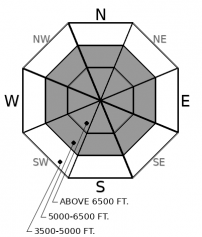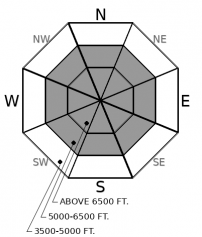| Monday | Monday Night | Tuesday | |
|---|---|---|---|
| Cloud Cover: | Mostly clear | Partly Cloudy | Mostly Cloudy |
| Temperatures: | 11 to 16 deg. F. | -5 to 0 deg. F. | 15 to 20 deg. F. |
| Wind Direction: | Northeast | Southwest | Southwest |
| Wind Speed: | 5 to 10 mph, gusting to 25 | 10 to 15 mph | 10 to 15 mph |
| Snowfall: | 0 in. | 0 in. | 0 in. |
| Snow Line: | 0 ft | 0 ft | 0 ft |
Whitefish Range
Swan Range
Flathead Range and Glacier National Park
How to read the forecast
The storm has ended but instabilities remain in areas of windblown snow. Changing wind directions has formed slabs on wind exposed slopes on a variety of aspects. Evaluate slopes harboring fresh wind drifts. Cracking or collapsing are obvious signs of instability.

2. Moderate
?
Above 6500 ft.
2. Moderate
?
5000-6500 ft.
1. Low
?
3500-5000 ft.
- 1. Low
- 2. Moderate
- 3. Considerable
- 4. High
- 5. Extreme
-
Type ?
-
Aspect/Elevation ?

-
Likelihood ?CertainVery LikelyLikelyPossible
 Unlikely
Unlikely -
Size ?HistoricVery LargeLargeSmall

Our recent storm resulted in over a foot of new snow in many locations. During the brunt of the storm moderate to strong southwest winds drifted new snow onto easterly aspects. Yesterday and overnight north and east winds drifted snow onto westerly aspects. Expect to find recent slabs in all aspects affected by the wind. Slabs will be thicker and more widespread below ridgelines and on cross-loaded features such as gullies. Cracking in the surface snow and hollow sounding snow are obvious instabilities.
-
Type ?
-
Aspect/Elevation ?

-
Likelihood ?CertainVery LikelyLikelyPossible
 Unlikely
Unlikely -
Size ?HistoricVery LargeLargeSmall

Buried weak layers exist in the bottom and middle of our snowpack. The recent storm added weight and stress to these layers which may make them more reactive to the weight of a rider today. Persistent slabs can surprise us by being remotely triggered resulting in an unusually large avalanche. This is a difficult problem to manage so it is best to default to terrain management. Slopes less than 35 degrees are your best bet until we can remove persistent slabs from our list of problems.
The recent storm was a great gift to end the year. Over 1" of Snow Water Equivalent and over a foot of snow was recorded at upper elevations. Moderate to strong southwest winds transported an impressive amount of snow during the peak of the storm. A wind shift during the day yesterday and overnight is resulting in loading on westerly aspects from north and east winds. Today, we should expect to find thicker older slabs on typical leeward aspects that will be stubborn to trigger. On atypical aspects, fresh thin slabs will be found. Human triggered avalanches will be possible on all aspects affected by the wind.
This storm tested the buried weak layers in the middle and bottom of our snowpack. However, we have yet to receive a report of an avalanche failing on these layers from this new load. Buried weak layers were formed early in the fall and have been gaining strength over time. It is becoming unlikely for a human-triggered avalanche to occur and after another day or two of observations, we will readdress our persistent slab problem. This problem is most pronounced in areas harboring a thinner and more variable snowpack such as the eastern end of our advisory. Areas of weaker snow, such as east of Essex, are where you are most likely to get in trouble.
An Arctic high pressure is producing cold temperatures, mostly clear skies, and north-east winds. A slight warming is expected tomorrow as winds shift back to the west with continued dry conditions.
This forecast applies only to backcountry areas outside established ski area boundaries. The forecast describes general avalanche conditions and local variations always occur. This forecast expires at midnight on the posted day unless otherwise noted. The information in this forecast is provided by the USDA Forest Service who is solely responsible for its content.































